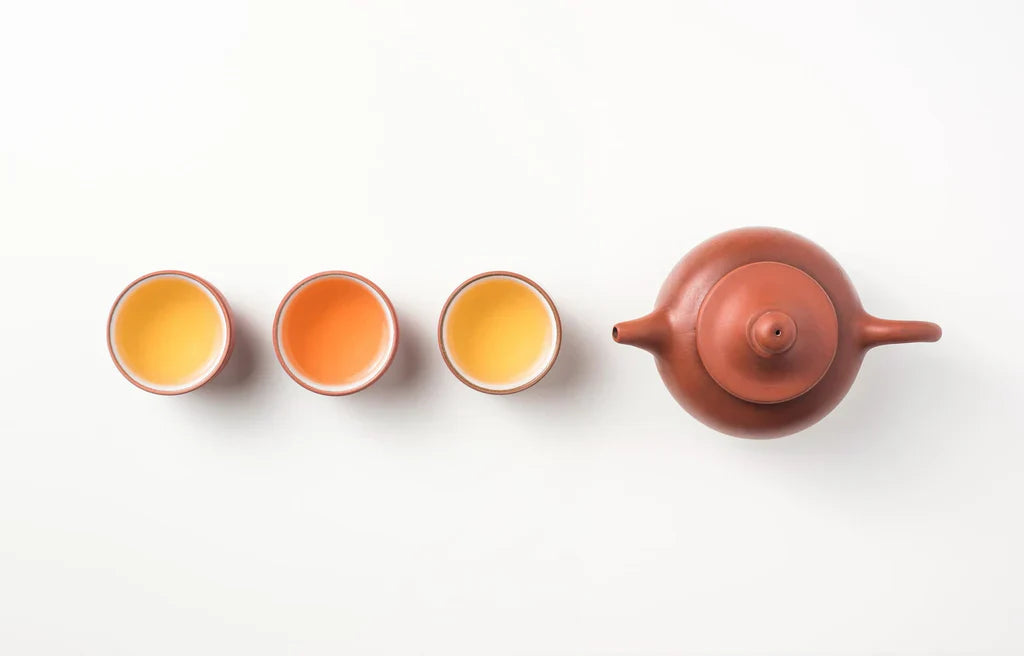
How To Drink Chinese Tea? - 8 Chinese Traditional Tea Drinking Customs
|
|
Time to read 3 min
|
|
Time to read 3 min
For thousands of years, Chinese people have refined the practice of drinking Chinese tea to its purest form.
When a few people gather to enjoy Chinese tea, all their attention is focused on it: brewing tea with great care, concentrating solely on the tea during tasting, avoiding any snacks, and even refraining from discussing topics unrelated to Chinese tea.
This purity is summed up in one word: “exquisite.” But what does this "exquisite" practice look like?
One essential aspect is the quality of water. Ancient wisdom holds that "mountain spring water is best, stream water is second, and well water is the least preferable."
Tap water is considered unsuitable for brewing tea. Tea enthusiasts often enjoy the process of fetching water from the mountains to make tea, finding it a very relaxing and delightful activity.
The type of kettle used to boil the water also matters. Iron kettles, aluminum kettles, stainless steel kettles, tempered glass kettles, and clay kettles all produce different sensations and effects when used to boil water.
Clay kettles are considered the most suitable, while metal kettles like iron or aluminum are seen as slightly inferior.
The way water is boiled is also a point of attention. The first choice is a red clay stove that uses charcoal. This small stove is aesthetically pleasing, with a lid and a door, and its firepower can be easily adjusted.
The second choice is a modern electric kettle. The water should be brought to an initial boil (when bubbles the size of fish eyes appear), forming "living water." If boiled for too long, it becomes "dead water." After removing from heat, it is best to wait a second or two before pouring the water, as using it too quickly can negatively affect the flavor.
Different tea types require different Chinese tea cups. For example, Wuyi rock tea is most often brewed in a gaiwan (a lidded bowl), but occasionally a Yixing clay teapot or a floating elegance cup is used.
Brewing in a gaiwan helps maintain the proper temperature and enhances the fragrance of the tea.
The way water is poured also matters—the speed, height, and thickness of the stream all make a difference. Some people like to pour from a high position, while others prefer a gentle, slow pour. The aim is to create a smooth flow, allowing the tea's life and vitality to unfold in the water.
This is the most crucial part of the process. The steeping time varies with each infusion and type of Chinese tea.
Different tea drinkers may also have different preferences. This aspect requires practice and tasting to get just right.
Choosing the right cup for tasting Chinese tea involves a significant amount of knowledge. The choice should follow four principles: small, shallow, thin, and white.
A small cup allows a single sip; a shallow cup prevents leftover water; a white cup enhances the tea’s color; and a thin cup, like paper, helps capture the fragrance. Sipping the tea should be done with small, slow sips to fully appreciate the taste.
The sound made while sipping enhances the flavor, similar to wine tasting. Beginners should start with slow and gentle sips to avoid gulping too fast and choking. Sipping Chinese tea is a slow and mindful experience.
After tasting comes the discussion: analyzing the aroma, the water, the aftertaste, the origin of the Chinese tea, the tree it came from, and the overall sensation.
Aroma: Chinese tea can carry various fragrances, such as orchid, magnolia, peach, almond, bamboo leaf, cream, pear, and more.
Water Quality: This does not refer to the water used for brewing but the Chinese tea infusion itself. Some may describe the tea as "thick" or "thin," "soft" or "hard," or compare its texture to things like honey or rice soup.
Tea Qi: "Tea Qi" can mean several things: a strong Chinese tea aroma, rich tea infusion, a full-bodied mouthfeel, bitterness and astringency, or the strong "force" that experienced tea tasters sense when the tea enters their mouth.
China is vast and rich in resources, and in recent years, the Chinese tea industry has seen significant growth.
With thousands of varieties of Chinese tea, each having its own unique qualities, tea artistry has blossomed into a diverse and intricate practice.
The depth of tea culture is boundless, offering endless opportunities for learning and enjoyment!
Describe your products, collection etc...
What are you looking for?









